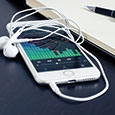
Technology in music education presents many opportunities, but also some significant challenges. The key is finding a balance between an embrace of technology and traditional music instruction as we know it.
Technology gives students access to mountains of knowledge, and with that development the role of the teacher has quickly changed from a dispenser of facts to a conduit connecting those facts with performance practice. In their book, A New Culture of Learning, Douglas Thomas and John Seely suggest that the role of the teacher has evolved into a bridge of two worlds – one that is information-based (software, web sites, search engines, and games) and another that is intensely personal. They say that what makes this new culture of learning so powerful is how the imagination is cultivated to “harness the power of almost unlimited and informational resources” to create something personally meaningful. The fusing of unlimited information and a structured environment (our world) fuels this new culture of learning, they say. “The primary difference between the teaching-based approach to education and the learning-based approach is that in the first case the culture is the environment, while in the second case, the culture emerges from the environment – and grows along with it,”
They describe this process as cultivation. A farmer takes nearly unlimited natural resources and consolidates these into a bounded and structured environment – a garden or a field. Thomas and Brown see the new culture of learning as a similar process of cultivating minds instead of plants.
My eye-opening experience with this dynamic echoes what Thomas and Brown say. In the past, it has been difficult to get jazz students to listen to professional recordings. The advent of YouTube made this easier because video piqued student interest. They can see the interactions between performers and the techniques first hand, particularly for rhythm section players. Students started to get into the habit of listening, but then a learning community engaged.
Students began sharing links to recordings and videos (among themselves and me), then started gathering in the school’s music production studio to listen together. Roles had changed. I used to dispense history and facts, but now my job is to help students connect the dots with the disparate facts and bits of listening.
They hear Clifford Brown, Dizzy Gillespie, and Louis Armstrong and enjoy it all, but I show them how it these seemingly unrelated parts tie together. I explain that before Louis, jazz vocabulary as we know it didn’t exist. Transitional big band players such as Roy Eldridge influenced Dizzy, who influenced a generation of players, including Clifford Brown. If they like Wynton Marsalis, I show how he is influenced by all of them. This culture of listening emerged without me saying a word.
Andrew Boysen, Director of Bands at the University of New Hampshire agrees that the rise of technology is changing how students learn and that the sword has two sides. He says easy access to recordings makes students better informed as they begin the preparation. “This has changed how I can approach my rehearsals, even for the first one,” he said. Student exposure to recordings coming in has led to an “increasing level of expectation for students’ performance and knowledge.’
The downside is that technology “is too easy sometimes…and too tempting to be distracted,” he said. Boysen contends that the ease of finding recordings can be a downside if students find inferior recordings or musical interpretations. In this case, Boysen must become the interlocutor that the new culture of learning describes.
Another challenge is cellphones and their place in a music classroom. At Cape Elizabeth High School phones are not allowed to be out during class. Whatever your policy is, it needs to be clear from the beginning. Make the point that the beauty of music is that you can’t multitask. For your students, music is one of the few times in the day when they are unplugged.
Technology has been a big boost in the teaching of percussion, according to Chris Marro, a freelance teacher active in southern Maine. Marro uses technology, particularly in teaching writing and recording, but seldom in teaching performance. “The act of doing outweighs the act of watching,” he said. Marro has found it necessary to teach students a balance between screen time and practice. “Solid practice requires the ability to disconnect completely and to be on task. This is difficult if you are checking the number of likes you have or your last social media post between each exercise,” he said.
Marro’s comments point to the changing role of the teacher as it applies to technology. If your band room isn’t a cell-free zone, you might consider that. The transition might have its challenges, but the result will be worth it. Your students deserve and need an unplugged part of their day. Technology has its place in our lives, but the tail can’t wag the dog.






